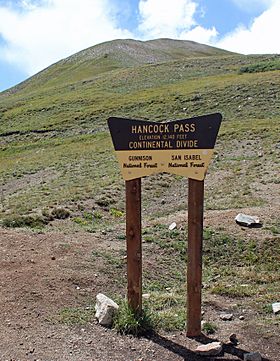Hancock Pass facts for kids
Quick facts for kids Hancock Pass |
|
|---|---|

The sign at the top of the pass.
|
|
| Elevation | 12,208 ft (3,721 m) |
| Location | Chaffee and Gunnison counties, Colorado. |
| Range | Rocky Mountains |
| Coordinates | 38°37′15″N 106°22′27″W / 38.62083°N 106.37417°W |
| Topo map | Garfield |
Hancock Pass is a high mountain pass located in western Colorado, United States. It sits at an elevation of 12,208 feet (about 3,721 meters) above sea level. This pass is a special pathway that crosses the Continental Divide, which is like a giant invisible line that separates where water flows across North America. Water on one side flows towards the Pacific Ocean, and water on the other side flows towards the Atlantic Ocean!
Hancock Pass is found right on the border between two counties in Colorado: Chaffee County and Gunnison County. It also separates two large protected areas: the Gunnison National Forest and the San Isabel National Forest.
Exploring Hancock Pass
Hancock Pass is part of the amazing Rocky Mountains, a huge mountain range that stretches across North America. Mountain passes like Hancock Pass are natural low points or gaps in mountain ranges. They have been used for thousands of years by people and animals to travel from one side of a mountain range to another.
Driving the Pass
The road that goes over Hancock Pass is not an easy one to travel. It is known for being quite rocky and rough. Because of this, you usually need a special vehicle, like a four-wheel-drive car or a sturdy off-road vehicle, to drive across it. The journey is often slow because of the challenging terrain. Drivers need to be careful and experienced to navigate the rocky path safely.
What You Might See
Even though the road is tough, the views from Hancock Pass are incredible. You can see vast landscapes of mountains, forests, and valleys. The area around the pass is part of national forests, which means it is protected land. These forests are home to many types of plants and animals that are adapted to living in high-altitude environments. Visitors might spot various wildlife or enjoy the unique alpine plants that grow in this rugged area.

